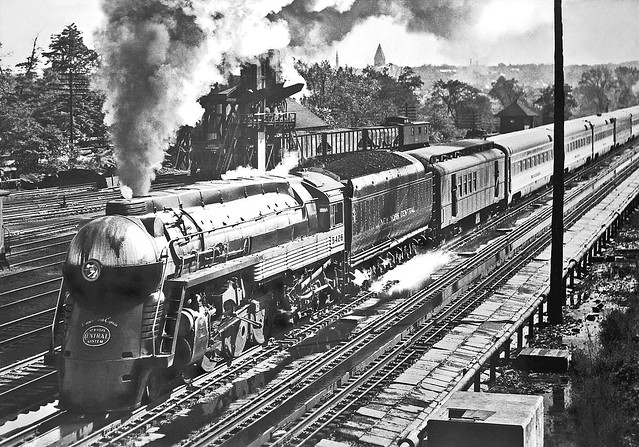If you watch cowboy movies, and sometimes other genres as well, you might hear about a “jerkwater town.” Such a town was a small, provincial, inconsequential village that nobody (who wasn’t, for example, hiding out after robbing the stagecoach) would ever want to visit. The term “jerkwater” is still in occasional use, and it’s applied to other things besides towns. For example, there can be “jerkwater colleges” (quote from 1970: “It won’t be easy for him to get another job if he’s fired … Maybe at some jerkwater college at half what he’s getting now”) and, in earlier times, vaudeville acts (“Vaudeville teams — from the jerkwater acts to specialists,” — that dates from1950).
But what does “jerkwater” mean, and where did it come from? It turns out that it’s a real thing that you might actually find in a small town (typically, but not necessarily, in the American west). It has to do with the advent of the railroads. Steam locomotives need water, and since the steam they produce is simply blown out into the air, the boiler needs refilling pretty often. That’s partly why steam locomotives kept getting built bigger and bigger; to accommodate the largest possible tank of water. But without a system to capture the steam and condense it back into water again (the last days of steam locomotives did that before the diesels took over), the train still needed to stop at the water tanks built beside the tracks by the railroad companies. Since the tanks had to be maintained, they were usually situated in or near towns.
So is the presence of one of those tanks what makes a village a “jerkwater town”? Nope, but it’s close. When the train had to stop for water, the point is that it had to stop. And any town the train stopped in had a source of business, even if it was only passengers stepping down for a few minutes to grab a drink in a saloon or have a shootout on main street (assuming the train had stopped exactly at noon, of course). What turned a perfectly ordinary municipality into a “jerkwater town” was the fact that the train didn’t stop; the town was so unimportant it was only seen trundling by, outside the windows of the parlor car. “Roll-through” country was the first version of “flyover country.”
But the trains still needed water, and it was available in the “jerkwater towns” though a system called “jerking water.” In 1860 a system was designed where a locomotive could lower scoops into troughs set beside the tracks and obtain water that way. It sounds like a Rube Goldberg contraption, but evidently it really worked — so well that as late as 1948 the New York Central System railroad was still using 19 of them. They might very well be still in use today if diesel locomotives hadn’t displaced steam. By 1948 the process was called “scooping water,” but up until at least about 1910 it was still known as “jerking water,” and the towns with those water troughs beside the tracks were “jerkwater towns”.
By the way, there are old films on YouTube of steam locomotives doing the scooping. They were able to do this without even slowing down, at up to 60mph (which, in the 1930s, was a pretty impressive speed).

